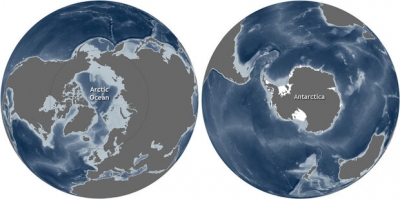
Any mention of our polar regions – the Arctic and Antarctica – perhaps conjures up images of floating icebergs and blindingly white ice sheets. Sure, that’s common to them but they are also different from each other in many ways.
The Arctic: A variety of landscapes and animals
Home to the North Pole, the Arctic lies in the Northern Hemisphere, and is the northernmost region of Earth. The Arctic usually refers to the area within the Arctic Circle, and spans the Arctic Ocean and parts of Scandinavia, Russia, Canada, Greenland, and Alaska (a U.S. State). It is not always covered in ice, and comprises mountains, rivers, lakes, hills, etc. It hosts several types of land animals and vegetation.
Antarctica: Just ice cover and barely any land animal
Our planet’s southernmost continent, Antarctica is where the South Pole is situated. It is almost entirely covered in ice, and hardly has any vegetation or large rivers or lakes to boast of. With barely any land animals, the largest creature to dwell on land is a wingless insect that’s about half an inch. There are hardly any trees there but Antarctica has its share of lichens, moss, algae, etc.
No penguins in the Arctic
Considering videos show glistening penguins diving into the water and launching themselves back on to ice-covered land adorably, it is easy to imagine that they inhabit both the polar regions. However, these flightless birds are found only in the Southern Hemisphere, and predominantly in Antarctica. None in the Arctic!
No polar bears in Antarctica
It is called a polar bear, after all, but the name is slightly misleading. It is an animal that lives in just one polar region – the Arctic. So, there are none in Antarctica. And, the next time someone asks you if polar bears hunt penguins in the wild, you can confidently tell them that can never happen because the two never get to meet each other!
A continent without permanent residents
Only a country can have permanent residents. And since Antarctica, though a continent, has no country, it has no permanent residents. It is not home to any indigenous community either. That does not mean Antarctica has just tourists. It hosts researchers and scientists at research stations set up by many countries for experiments, especially in summer. In winter, the numbers dwindle. Hard to imagine people queuing up to be a resident in a place with punishing temperatures! On the other hand, the Arctic does host permanent residents, especially indigenous groups, since it spans several countries. In fact, it has been inhabited for thousands of years.
Summers and winters
Due to the way our planet is tilted, the poles receive less light and heat from the sun than other regions of the world. The two seasons- summer and winter – are unique. Both the polar regions have long and cold winters and short summers. During summer, the poles have daylight since the sun does not set, and in winter, it is dark since the sun does not rise. However, since the Arctic and Antarctica are in the opposite directions, when one region experiences summer, the other experiences winter, and vice-versa.
Picture Credit : Google




